As an Amazon Associate I earn from qualifying purchases.
Nixtamal. Such a cool word! It is to Mesoamerica what hominy is to the United States: corn treated with an alkali substance to render it more nutritious, easier to grind, and, to many, tastier and more aromatic — think about the smell of a Mexican corn tortilla and that’s nixtamalization you are smelling. Here’s how to do it at home.
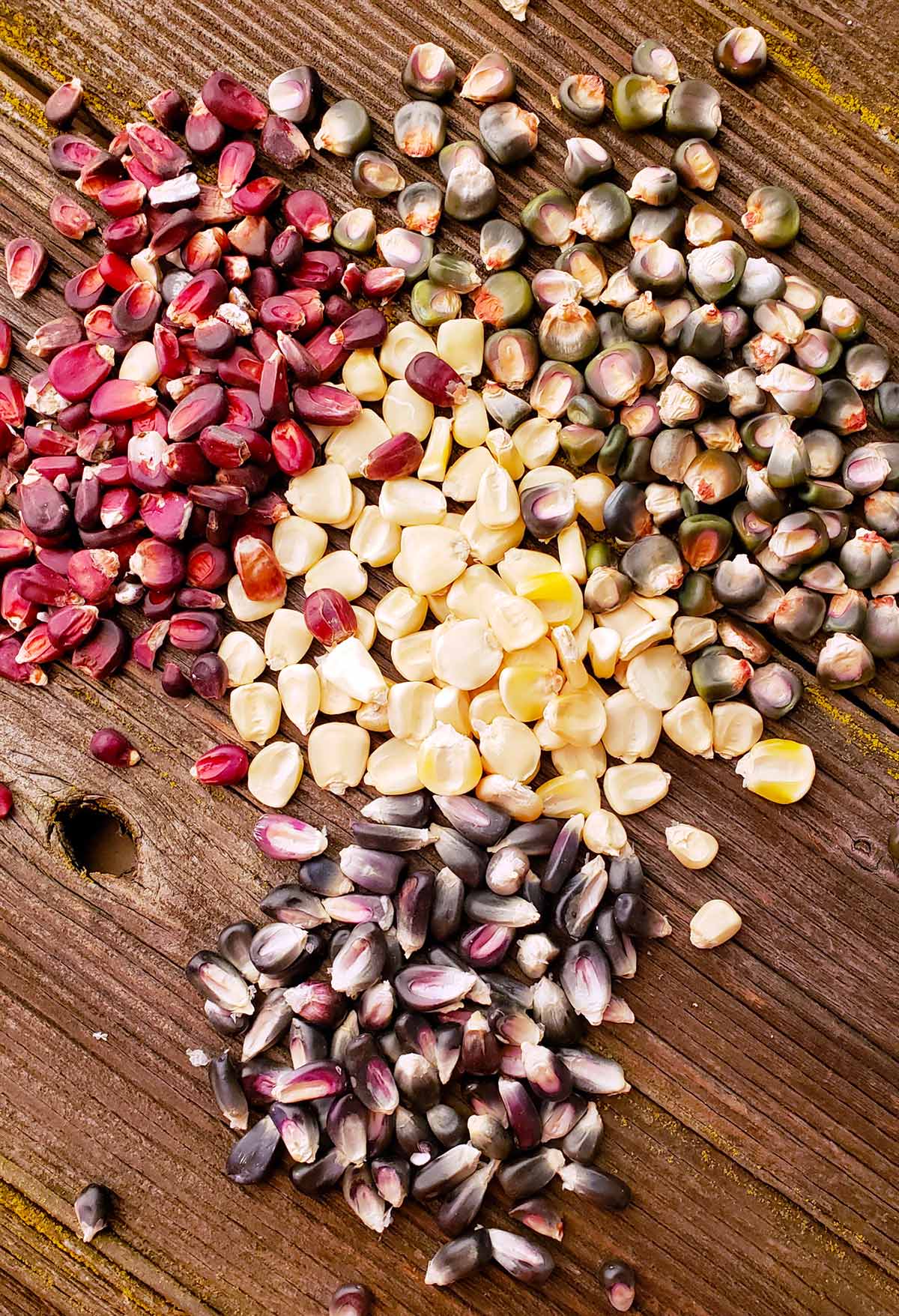
Nixtamal or hominy are featured ingredients in a number of traditional dishes throughout the US and in Mesoamerica, primarily the American South, Mexico and Guatemala. Most of you know about hominy grits, which are regular grits made with nixtamalized corn; I like those made with white corn.
You will also see hominy in many soups and stews, most of which date back 500 years or more. The most famous soup with nixtamalized corn is pozole, which is arguably the national dish of Mexico, and which has a wide variety of styles; here is my recipe for red pozole, pozole rojo, and here is my rendition of white pozole, pozole blanco. Menudo also features nixtamal.
Primarily, however, you use nixtamal to make masa, dough for corn tortillas and tamales, as well as other tasty corn-based treats like tetelas or masa empanadas or Central American arepas. Nixtamalization is what allows corn to become an actual dough that will stick to itself.
What follows is how to make nixtamal, or hominy, at home. Why bother? A variety of reasons, really.
- First, industrially canned hominy is nasty, a far worse product than what canned beans are to dried.
- Second, homemade masa dough is amazing, as much of a revelation as is making pasta from freshly ground flour.
- Third, when you make your own masa dough by nixtamalization, it will stick to itself better than industrial masa harina, which is dehydated masa.
You also can make cool little masa dumplings with fresh dough, like the chochoyotes in my venison mole. This won’t work with masa harina.
Corn for Nixtamal
Making nixtamal is easy, once you are set up for it. First, you need dried corn.
Keep in mind that while any dried corn can be nixtamalized, not any dried corn makes good masa dough. More on that later. But if you just want corn in a stew or soup or whatever that tastes better than regular ole’ corn, any field corn will work. So far as I know, sweet corn is not nixtamalized, and it’s almost never dried anyway.
I get my field corn from a variety of sources. Mexican corn from Masienda, a Los Angeles-based company that imports heirloom corn from Mexico; I’ve bought red bloody butcher corn from Breadtopia.
The best corn for nixtamal is flour corn, usually grown in Mexico. After that, in order of preference, I’d go with dent corn, then flint corn, then popcorn.
I also grow field corn in my garden. My advice for good seed for field corn is to look up Native Seeds Search, the Seed Savers Exchange or Southern Exposure Seed Exchange. Just a note: field corn takes all season to grow, so plant it in spring according to how corn is grown where you live; check your local Cooperative Extension if you’re not sure.
Getting Ready
Measuring. While you don’t need to do this, it makes for better nixtamal if you do. The standard ratio for nixtamal starts with the weight of the corn. Then, 1 percent of the corn’s weight in cal, which is calcium hydroxide, sold as pickling lime or slaked lime in some places and cal in Latin markets.
As a side note, if you are using red corn, you will want to reduce the amount of cal to about 0.75 percent of the corn by weight; this helps keep it red. You can also shock the corn back into its proper color by dousing it with vinegar after it’s soaked overnight and rinsed. You would then rinse away the vinegar after the red color returned so you don’t have acidic nixtamal.
Similarly, if you use too much cal, you can turn blue corn weird greenish colors. Oh, and if you drop something acidic on a blue corn tortilla, it will turn it pink. Fun with chemistry…
After that, if you want to get technical, double the weight of the corn in water. I rarely do this, instead covering the corn by a depth of 1 inch. You do not want a ton of water in the nixtamalization process, or else the cal with be too diluted to work. Different cooks do it differently, and there are multiple ways to get to nixtamal. Here’s mine.
Simmering the Corn
Boiling. Bring the water to a boil, or, put the corn in the pot and cover by an inch and then bring it to a boil. Stir in the cal at some point before it boils.
You should see the corn immediately change color, usually there will be some sort of switch toward yellow. Weirdly, red corn turns black. Drop the heat to a simmer and simmer the corn for at least 30 minutes. Stir the pot every five minutes or so, to keep the cal well distributed.
After 30 minutes, check a kernel. Bite it in half. You want to see it about half cooked, but with a white, chalky center. Some corn can take an hour to get to this point, but start checking at a half hour.
When you are ready, turn off the heat. If your pot is heavy, like enameled iron, move it off the burner so it cools faster. If it’s a regular steel pot, keep it on the burner for some residual heat.
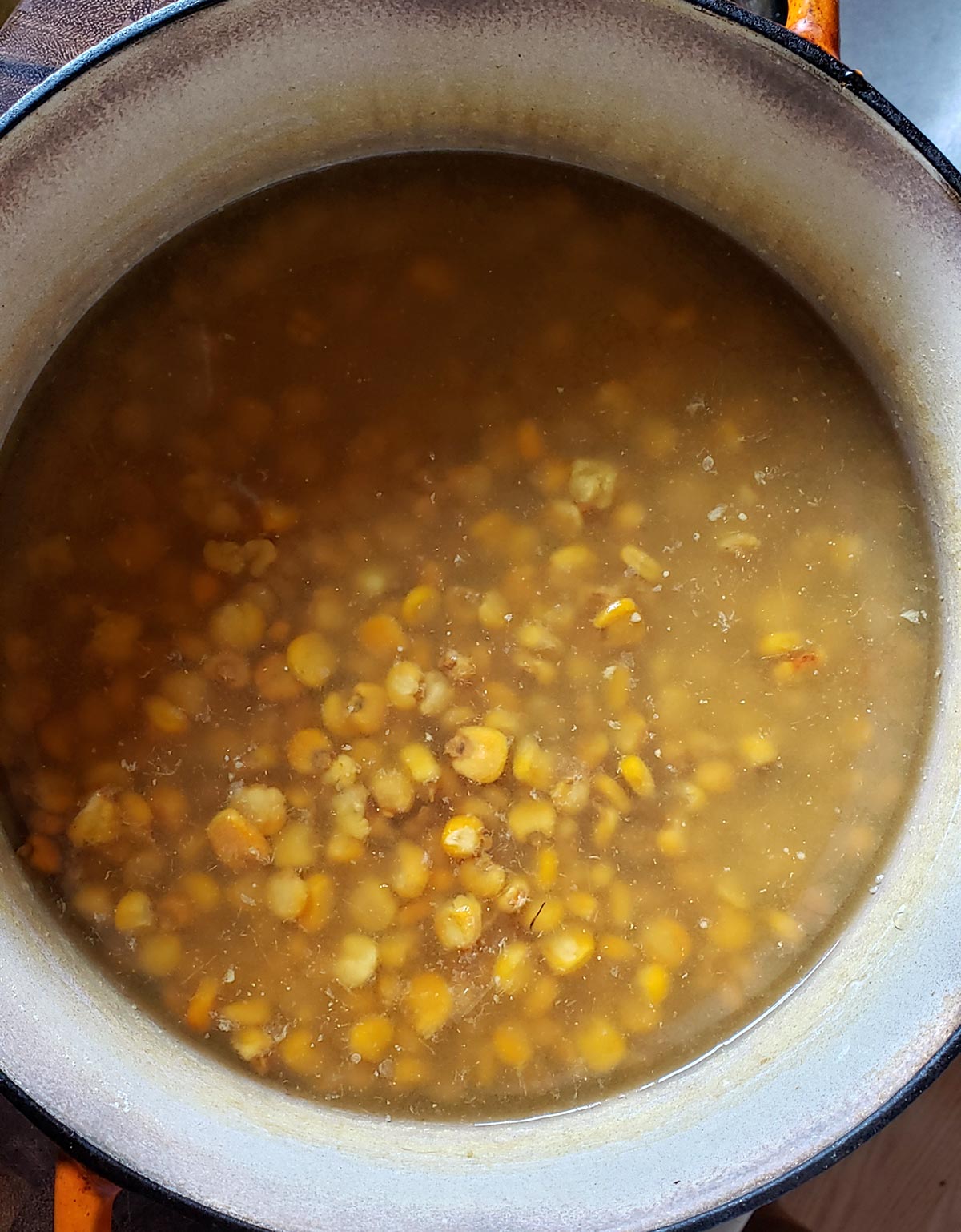
Nixtamal Happens Overnight
Waiting. You need the corn to soak for 8 to 12 hours at room temperature. If the corn has soaked up a lot of water after the boil, pour in enough so the corn is covered by about 1/2 inch. Cover and let the pot set overnight. It takes that long for the calcium hydroxide to fully do its work.
After you’ve let the corn soak, you will see your pretty corn swimming in a sea of sludge: That’s the pericarp, or outer coating, that has sloughed off. That’s good.
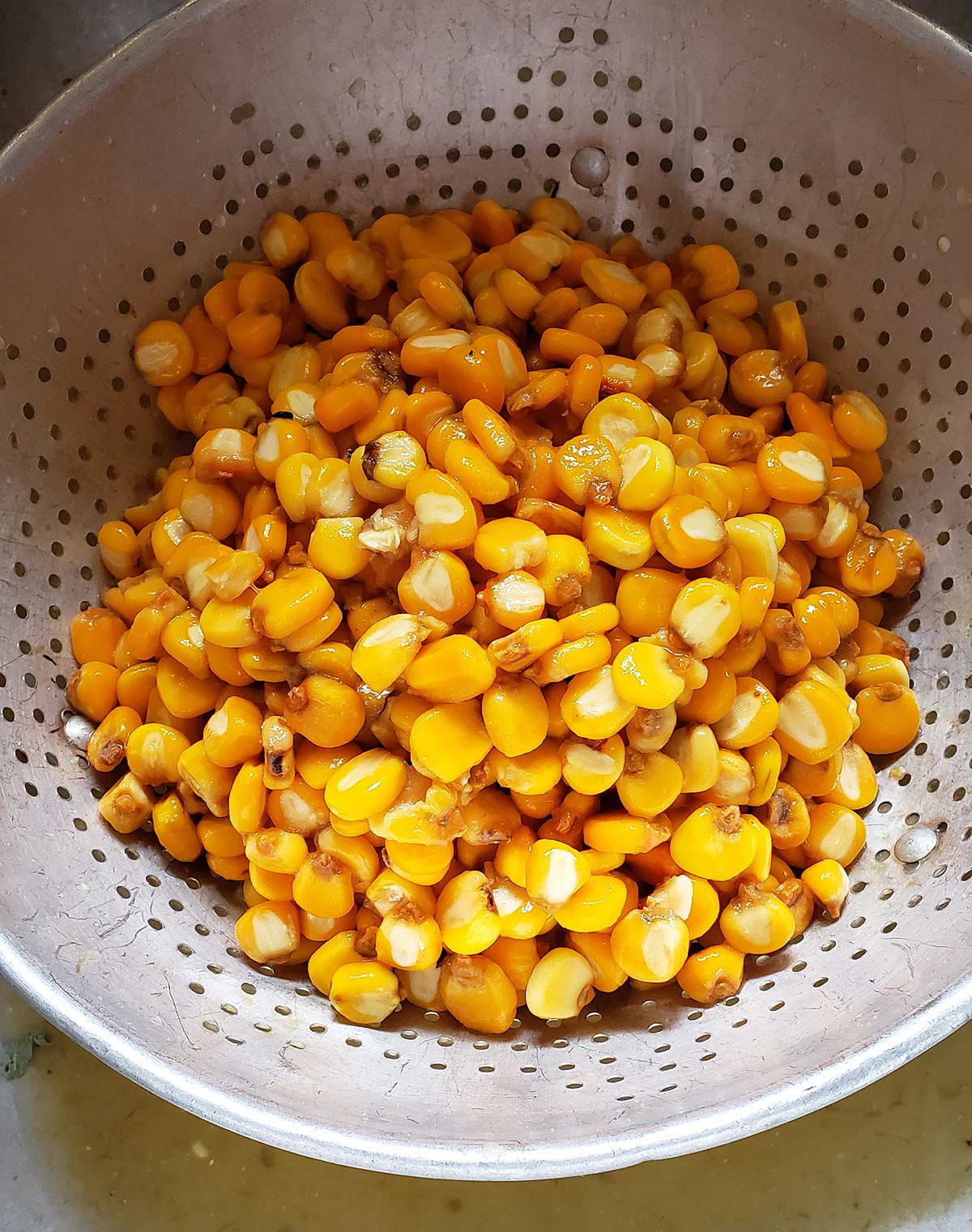
Rinsing and Rubbing
Rubbing and rinsing. You now need to rub off most or all of the remaining pericarp with your hands. Do this about 5 minutes or so, all in the sludgy water. Here’s a short video on how to do it.
Now, if you are making masa dough, save about a cup of that water, more if you are working with more than 2 pounds of dried corn. You’ll need this later.
Set the corn in a colander and rinse it well. Really well if you are using it whole-kernel for soup. You will notice that the sludge will collect in your sink’s screen. Periodically clean the screen. Leave a bit of the sludgy stuff on if you are making masa dough, get it all off of pozole or hominy grits. You now have nixtamal.
What to Do with Nixtamal
Now that you have nixtamal, normally you’d do one of two things: Grind it for tamales or tortillas, or keep it whole for pozole. I usually make a big batch, then grind it all in my corn grinder (yes, I am that crazy I have one), then make homemade masa harina with the rest for later.
Or, I will use the whole kernels in stews like the abovementioned pozole, of which I have many versions on this site. Pozole rojo, white pozole, pozole verde, and a Sonoran version called gallina pinta all use whole kernel nixtamal.
If you are not using it right away, you can dry nixtamal completely and use it as needed; it does take a long time to rehydrate and cook later, so keep that in mind if you use it in a stew down the road.
If you liked this recipe, please leave a ⭐️⭐️⭐️⭐️⭐️ rating and a comment below; I’d love to hear how everything went. If you’re on Instagram, share a picture and tag me at huntgathercook.
How to Make Nixtamal
Ingredients
- 1 kilo dried field corn, 2.2 pounds
- 10 grams calcium hydroxide, "cal" in Mexican markets
- 1 gallon water
Instructions
- Cover the corn with the water and stir in the cal. Bring to a rolling boil, stir, then drop to a bare simmer. Let the corn simmer, partially covered, for at least 30 minutes.
- Take a kernel out and bite it in half: You want to see it mostly cooked, but with a white, chalky center still. This can take as long as an hour, but start checking at 30 minutes. When the corn hits this stage, turn off the heat, stir once more, cover the pot and let it sit overnight.
- The next morning, use your fingers to sift the kernels in the now-sludgy water. You want to rub them well to remove the slimy pericarp. Pour the contents of the pot into a colander to drain. You will want to clean your sink's screen as the sludgy stuff will clog it.
- Rinse out the pot, then return the corn to it. Cover with fresh, cool water. Rub the kernels some more to get most of the pericarp off. (Here's a short video of the process.) Rinse in the colander one more time. You now have nixtamal.
Nutrition
Nutrition information is automatically calculated, so should only be used as an approximation.



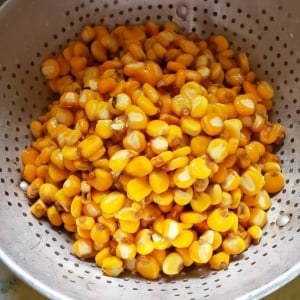
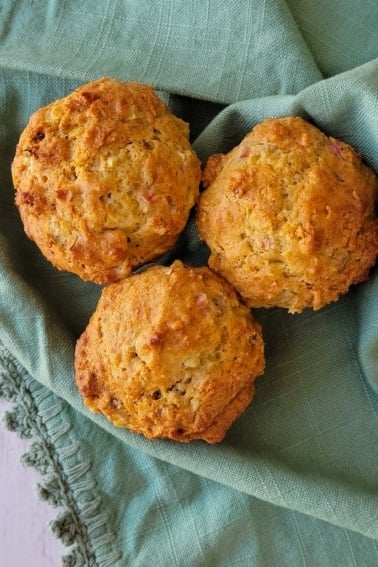
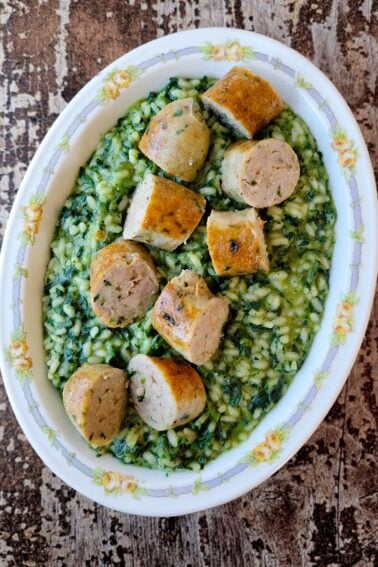
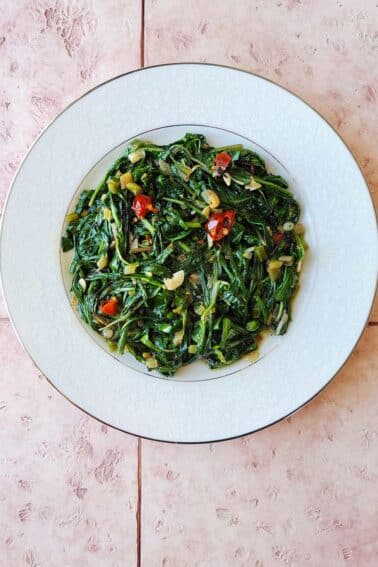
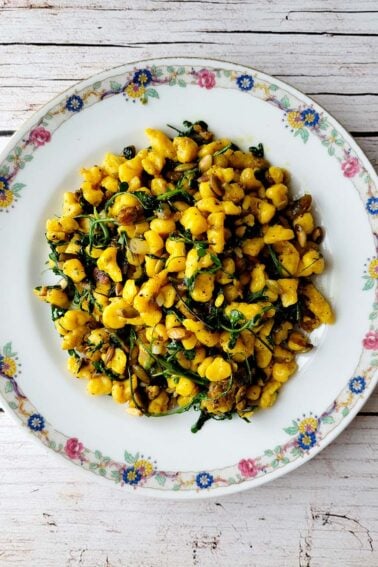
Great article, inspired me to attempt my first batch today.
Any idea how many tortillas I should expect from a 2.2lb bag of corn?
Thanks for the in-depth article. I’m wondering if there is some kind of use for the leftover pericarp. For whatever reason, I cringe at the thought of throwing it out. You mentioned using some of it to make dough. Anything else? Thanks!
Thank you for this very informative article.
I grew an heirloom variety of white corn. Not too sure if it’s flour or flint, bought a corn mill only to get stuck on what to use and the ratios in order to process it.
so looking forward to getting started on this!!
Great article. I’ve done this before to make niacin available, but was mostly shooting in the dark. This is very helpful.
Maybe I missed it, but can you let me know what quantity the nutrition info is for. For example the nutrition info is per what weight of dried corn? Wet corn? What is considered a serving size?
Many thanks!
Thank you, I love your recipes
I have a “bumbling urban farmer” question: will nixtamalization kill pathogens?
I harvested my first-ever flint corn from my garden in August and shucked the cobs in early September when the kernels were hardened. I then made a rookie mistake and put the “dried” kernels directly into a pint jar with a couple of dehydrator packets. I opened the jar today and was shocked when it “burped” like a fermentation jar. The kernels feel dry to me but did clump together a bit when I dumped out the jar. Do I need to throw everything out or can I salvage the situation somehow?
Meg: Huh. Hard to say. I think the boiling process may well kill anything bad in there. But I am not sure.
Hi Meg, my advice is not to eat that corn, regardless of cooking or lime process. Farmers will dry down field corn to 15% for short term storage or 12% for long term storage. This is why you see corn in the field even in December, it’s too moist for them to harvest. Too moist and the risk of fungal or bacterial growth is very high.
Do grow dent corn again, this time harvest in late September or early October. When you store it put it in a paper bag, never a glass jar or plastic bag.
Hope this helps,
Catherine, retired horticulturist, 21 years with U of Wyoming.
if I wanna make 15 pounds of corn, into hominy, how much cal would that be in ounces…. I can not seem to figure out the math.
Roxanne: 2.3 ounces of cal is what you need. If you can’t get an exact 2.3, go for 2 ounces.
First off, I love what you do. So often when I search Google for new things to cook with or new recipes to try, I find myself reading a Hank Shaw recipe. Seems like we occupy the same orbit. Thank you.
So, I tried making nixtamal this weekend using oak wood ash from my pellet stove to make my alkali solution. I processed it for about 8 hrs fully understanding that the corn might not be fully processed internally. I rubbed and rinsed off the pericarp, it took about 4-5 times until the water was clear. Everything LOOKED good, but I didn’t taste the corn before processing it further. I wet ground it in my meat grinder and made a basic grits recipe.
When it started to thicken, I tasted it and got a strong alkali/tannic taste much like what happens when you bite into a raw acorn. I used blue corn and it turned yellow, so I don’t think I used too strong of a solution. What do you think I did wrong? Am I supposed to soak the corn in clean water for a period of time after nixtamalization to extract the remaining alkali solution out of the processed corn kernels (similar to leaching tannins from acorns)? I want to try again with ash, but don’t know what I did wrong and don’t want to waste more corn. Any suggestions would be appreciated.
Curt: I actually am not an expert on the wood ash method of nixtamalization, sorry. I only use the cal you get in Mexican markets. My first thought is that the alkali solution was too strong. The color change is an indicator: Blue corn stays blue when nixtamalized, so you may have used too much ash? Just a thought.
I have some food grade Sodium Hydroxide I use for Pretzels . Can I use this instead of the Calcium Hydroxide? Much higher ph…like 10x I believe. Any idea how much?
Can you explain to me why you can not just use fresh corn on the cob to make masa? I have looked for an answer to the question for a year. We boil corn on the cob and eat it, so it seems strange to me that you can not just grind it up to make masa for tamales. I understand the whole nixtamalization process, and how it gets rid of the husk. But, there has to be another reason for only using dry corn. I must be missing something simple. Please explain.
Jim: Because the corn must be fully ripe and dried to even start. Masa requires particular starches in corn that are only developed once the kernels are ripe. Fresh corn is by definition unripe. There’s a sugar stage, where we like to eat it fresh, that becomes a starchy phase, which is the ripening. Once the corn is then fully ripe and dried, you must cook it with an alkaline agent to slough off the pericarp, which unlucks corn’s full nutrition as well as the starches that allow the dough to stick to itself. Hope that helps.
I don’t mean to be the “well, ackshully” guy, but this isn’t quite right.
There are two main varieties of corn raised by humans: sweet corn and field corn. Sweet corn was selected for a mutation which hampers the conversion of sugar to starch, leading to a sweeter product. It’s eaten while still immature as the mature grain is less sweet and very tough. This is not the type of corn used for masa, but instead the type humans cook and eat with little to no processing. Sweet corn is by far one of the least grown corns, accounting for less than 1% of corn grown in the United States.
Field corn lacks the starch conversion mutation of sweet corn, making it starchy, not sweet. It’s allowed to fully mature, dry, and harden on the cob before harvest, after which it’s used for human or animal consumption, or as a feedstock for a variety of industrial processes, like ethanol generation. Compared by weight to sweet corn, it’s much more nutritional dense, with 5 times more calories, 10 times more fats, over 6 times more protein, and a higher concentration of vitamins and minerals. This is the corn used for nixtamal and is the most grown corn, being somewhere around 98-99% of corn production, at least in the United States.
Regarding nixtamalization, there are a few reasons for its utility. Field corn is a PITA to process by hand, so it makes it easier to process by breaking down the pericarp, the tough outer shell, and substantially softening the endosperm, the starchy material that makes up most of the rest of the kernel. This is also what makes it able to form a dough, while untreated corn starch will not. It frees niacin from its bond with hemicellulose, making it bioavailable, and increases the calcium content, at least when calcium hydroxide is used. It breaks down nearly 100% the mycotoxins formed from the fungal infection common amongst almost all corn. Finally, it just tastes better as nixtamalization increases the smell of the corn, thereby increasing the flavor.
Thank you for this wonderful article. Do you think a small quantity of wet nixtamal could be ground (with some patience and some elbow grease) in a molcajete?
Stephen: Sure. But it’ll be hard work.
Stephen, the traditional way to grind masa between stones is with a metate and mano. The metate is expensive, heavy, hard to find and it can take hours or days to complete a batch of masa with it. Your hands and upper body will be sore for days but if you can follow through with it, I believe the masa it makes is just slightly better than the one made with a grain grinder. The molcajete is not made for this purpose and it will be much more difficult, and you might get specks of stone in your masa from the force needed.
I’m guessing step 5 is grind the Nix into a very fine (wet) paste and then (step 6)dry the paste low and slow? After it’s dried use whatever method available to turn the dried paste into something like a flour. Make the tortillas or whatever with the flour. Sound right?
Scott: Yeah, you grind the wet corn as best you can. Ideally you grind it fine so you can use it in tortillas right away, but getting a fine grind on wet things can be tough without a specialized grinder, like a Victoria hand grinder or an Ultra Dura or a molinito. So you can get it as ground as you get when wet, then dry, then pulverize into flour when dry.
Hi Hank,
I have just found this site, thank you for posting this info?
I have a Little Ark mill, (from Idaho) I bought around twenty five years ago. It has metal grinding plates for wet seeds do I’m guessing that they would be suitable for the initial grounding process?.
Just to clarify; I could then dry the results of this process and feed it through the mill a second time with the stone grounding plates to achieve a finer dried flour.
Thanks again, cheers.
Kevin
Kevin: Sounds like it, although I am not familiar with that mill. And yes, you can grind again once it’s dry.
Hi…..great article. I have a No. 10 and a No. 32 Enterprise cast iron meat grinders. The No. 10 will grind a whole prepared whitetail in about 20 minutes without breaking a sweat…..in normal Autumn weather here in Ohio. Is there any reason one of these would not work on this corn in its softened state? Maybe using the medium plate? Otherwise I have the dehydrator and the Vitamix dry grains container. Thanks very much for your expertise.
Dean: It will definitely grind the corn well coarsely, but you can’t really grind anything to a powder in a meat grinder. Maybe start with that and move to the Vitamix?
Thank you for the thorough instructions for making nixtamal. I made a large batch of around 5 pounds and then dehydrated it to use as needed. I would mention that with a larger quantity, I should have taken it outside to a water source for rinsing because I soon realized it was best not to put that sludge down my kitchen drain. Just a thought. Also, do you have a favorite white corn variety for making hominy?
Hi Hank thank you for your thorough and detailed explanation.Please i tried your method for the pop corn type corn, because i cant find the flat corn and it simply did not work after 30 minutes of boiling and filled water 2 inches above because the boiling evaporated the water almost immidiately.So the Result was i rinsed it and after grinding it is still has dry lumps and not even cooked. Please what do you advise me to do? thanks
Albert: You need to simmer until the kernels are about half done, so if that means adding more water, you need to do that.
I’m looking forward to making this. Can it be freeze dried….making ‘corn nuts’?
JM: I don’t know, sorry.
Hi Hank,
I love this article! It is so in-depth. I live in Vermont and am super interested in giving It a try to make my own Nixtamal for tortillas. I have some room in my garden for the corn for this purpose, and wondered what characteristics I would be looking for when seeking heirloom corn varieties that will grow up here.
Joni: I think in Vermont you will want to grow flint corn. Flour corn is traditional for tortillas, but it can be hard to grow in the north.
You might want to look into Mandan Red Clay (or Lavender Mandan). It is a flour corn originating from the Mandan tribe in North Dakota. It’s a very early variety only 4-5ft high and often makes only 2 cobs but can make up to 6-8.
Painted Mountain from Montana is available from High Mowing Seeds in Vermont. I’ll be turning last summer’s harvest into posole this week. Posole is whole dried nixtamalized kernels. They can ne used in stew or resoaked and ground to make tortillas.
Can I make nixtamal using popcorn kernels?
Chanel: I believe you can, but I have never tried it.
Please, I found this sentence confusing because it can mean at least two things:
“…if you want to get technical, double the weight of the corn in water…”
Does it mean use twice as much water in weight as the weight of dry corn? Such as: 500 grams of dry corn, 1000 grams of water? (And 5 grams of calcium hydroxide?) And another question, if I may:
What if my corn is very old, say 10 years. If I pre-soak it first before cooking I get softer corn. Do I soak it in plain water or water with the appropriate amount calcium hydroxide? Or so I skip a pre-soak altogether and just cook longer with calcium hydroxide?
Eelbrood: Yes on that first question. As for 10 year old corn, wow. I’ve never heard of someone trying to cook that. Good luck there. But if I were to try it, I would indeed soak in regular water overnight, then proceed as normal. It might take more than 1 hour to get to that al dente stage, though.
Hello Hank,
Our family is very interested in wild foods. I’m not sure this post is particularly about wild foods, but it is important to me. I would say the point of teaching how to nixtamalize with wood ash is that someday, and in some locations, commercial lime/cal/pickling lime isn’t/won’t be available, whereas wood ash is (theoretically) always attainable. Do you have the data for making nixtamal with wood ash? Also, I am concerned that your post doesn’t tell the reader to wear gloves or to rinse the cal/lime solution off before putting your hands in there to rub the skins off. I would guess that the pH of the water is (or should be) pretty basic, which can burn the skin just as acid can.
JHH: I don’t really know a ton about using wood ash because the cal is such a better method, more precise and easier. And it’s been used for several thousand years. As for the gloves, no one uses them. The water is fine. Remember we are not putting lye into the water. There is a gigantic difference between lye and pickling lime (cal).
I too stumbled on this educational site from wanting to make corn nuts. I am in a small town in Mexico. The tortillaria sells tortillas, masa and nixta. I haven’t been able to find a translation but I am guessing it may be lime or treated whole corn. There is a corn liquor called Nixta, but I doubt that it is liquor. Further research is in order.
Brian: Yes, nixtamal is treated whole corn. Calcium hydroxide is added to it during the cooking process. That is the subject of this article.